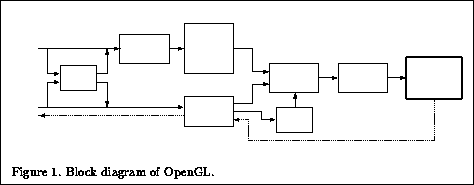In this section we present a brief overview of OpenGL. For a more comprehensive description, the reader is referred to [8] or [13].
OpenGL draws primitives into a framebuffer subject to a number of selectable modes. Each primitive is a point, line segment, polygon, pixel rectangle, or bitmap. Each mode may be changed independently; the setting of one does not affect the settings of others (although many modes may interact to determine what eventually ends up in the framebuffer). Modes are set, primitives specified, and other OpenGL operations described by issuing commands in the form of function or procedure calls.
Figure 1 shows a schematic diagram of OpenGL.
Commands enter OpenGL on the left.
Most commands may be accumulated in a display list for processing
at a later time.
Otherwise,
commands are effectively sent through a processing pipeline.

The first stage provides an efficient means for approximating curve and surface geometry by evaluating polynomial functions of input values. The next stage operates on geometric primitives described by vertices: points, line segments, and polygons. In this stage vertices are transformed and lit, and primitives are clipped to a viewing volume in preparation for the next stage, rasterization. The rasterizer produces a series of framebuffer addresses and values using a two-dimensional description of a point, line segment, or polygon. Each fragment so produced is fed to the next stage that performs operations on individual fragments before they finally alter the framebuffer. These operations include conditional updates into the framebuffer based on incoming and previously stored depth values (to effect depth buffering), blending of incoming fragment colors with stored colors, as well as masking and other logical operations on fragment values.
Finally, pixel rectangles and bitmaps bypass the vertex processing portion of the pipeline to send a block of fragments directly through rasterization to the individual fragment operations, eventually causing a block of pixels to be written to the framebuffer. Values may also be read back from the framebuffer or copied from one portion of the framebuffer to another. These transfers may include some type of decoding or encoding.